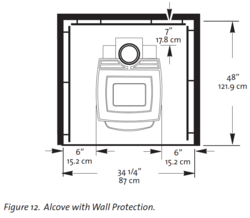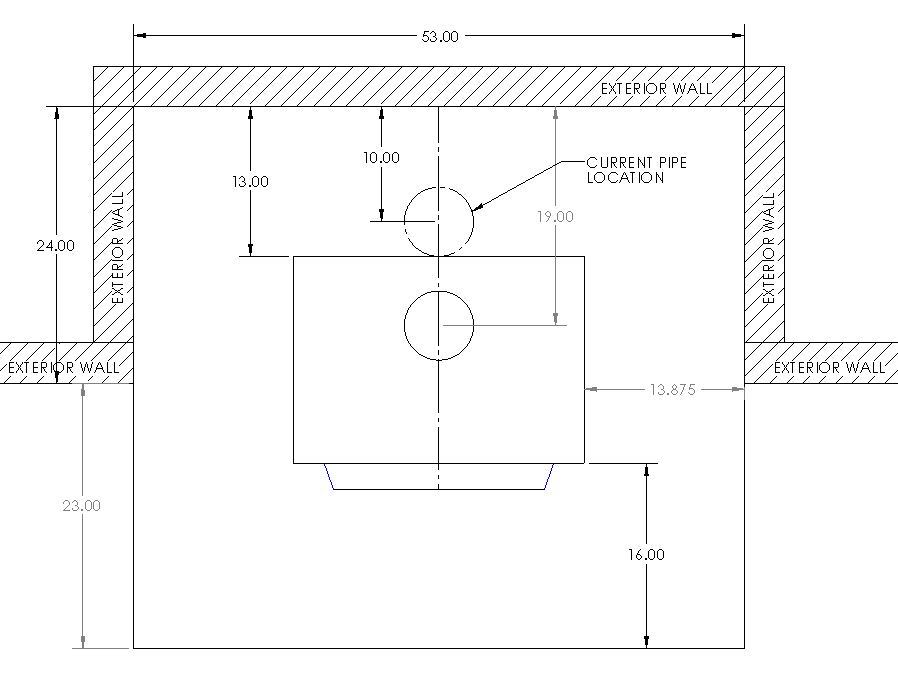After discovering I have a contractor grade ZC fireplace (class A chimney), my project wasn't going to be as simple as putting in an insert. I posted about this before and my options are to install a ZC insert ($$$) or tear everything out and do an alcove freestanding stove. I want to get this project rolling and opted for the alcove with the freestanding.
The house 1250 sq ft and I am baselining the Englander 13NC because the price is right and it seems a lot of people are happy with it. I live in western Washington (King County). I think the 13NC will be a good fit for our house/climate. As of right now I'm hoping for an end result similar to this (pulled from google image search): http://i.imgur.com/DxLFN5s.jpg
Finally got around to taking some measurements and making a layout to see what kind of clearances I can get with where the current flue is. I'm not reusing the old chimney, but it would be nice if I can go straight up with the new chimney. Here is my current layout with the 13NC drawn in:
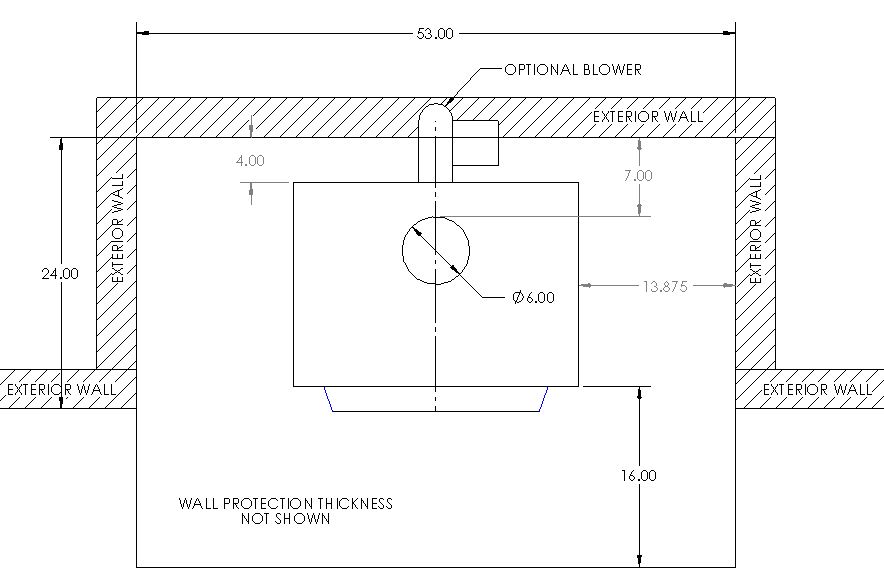
I checked with WA state codes for clearances and it said to refer to the manufactures clearances. From the 13NC manual, here are the required clearances and some other info:
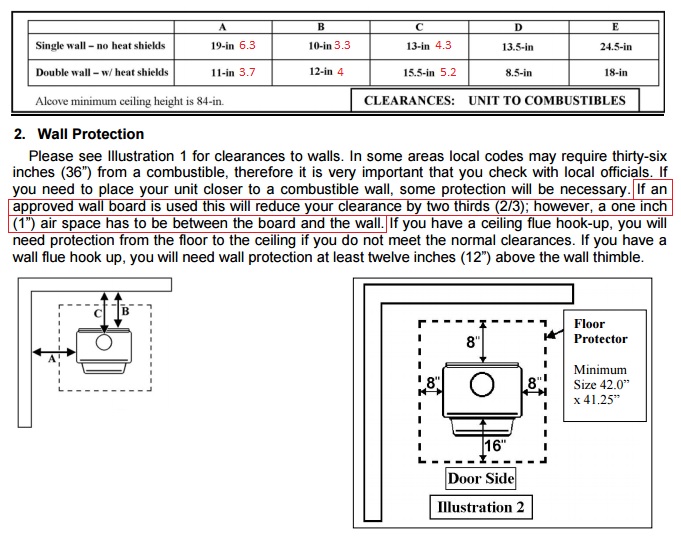
My drawing does not show any of the wall protection (just shows the structure framing), so that will add another 4"-5" (I'm guessing). It looks like I am okay for the sides, even without heat shields; however, the back is too tight once I consider the wall protection. And, if I want to use the blower I will need a bit more room. Looks like I'll have to move the stove out about 10" and end up having a jog in the chimney as it goes up through the attic. Not the end of the world. Any thoughts on the layout? There is the note about the 8" behind for the floor protector, but I think that is assuming no wall protection...otherwise the clearances in the table don't make sense.
I got to looking at the King County requirements and stumbled across a note about the combustion air supply:
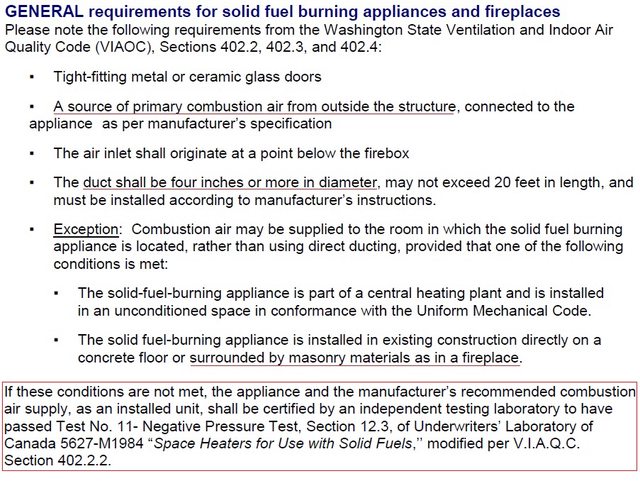
Reading this I was thinking I need an outside air supply, but because the stove is certified for WA state, it makes me think the stove passes the "Negative Pressure Test" that is noted at the bottom and that I don't need an outside air supply. Pretty sure, since the duct on the stove is 3" and the note calls for 4" anyways.
I think that is it for now. Still doing research and I plan on stopping in at a local wood stove shop to see what they think as well. I'd love to get some input from the forum, though.
Oh, other things I found out is that a mechanical permit will cost me about $200 and that my homeowner's insurance has a ~$40/yr surcharge for free-standing wood stoves (no surcharge for inserts)!
Thanks!
The house 1250 sq ft and I am baselining the Englander 13NC because the price is right and it seems a lot of people are happy with it. I live in western Washington (King County). I think the 13NC will be a good fit for our house/climate. As of right now I'm hoping for an end result similar to this (pulled from google image search): http://i.imgur.com/DxLFN5s.jpg
Finally got around to taking some measurements and making a layout to see what kind of clearances I can get with where the current flue is. I'm not reusing the old chimney, but it would be nice if I can go straight up with the new chimney. Here is my current layout with the 13NC drawn in:

I checked with WA state codes for clearances and it said to refer to the manufactures clearances. From the 13NC manual, here are the required clearances and some other info:

My drawing does not show any of the wall protection (just shows the structure framing), so that will add another 4"-5" (I'm guessing). It looks like I am okay for the sides, even without heat shields; however, the back is too tight once I consider the wall protection. And, if I want to use the blower I will need a bit more room. Looks like I'll have to move the stove out about 10" and end up having a jog in the chimney as it goes up through the attic. Not the end of the world. Any thoughts on the layout? There is the note about the 8" behind for the floor protector, but I think that is assuming no wall protection...otherwise the clearances in the table don't make sense.
I got to looking at the King County requirements and stumbled across a note about the combustion air supply:

Reading this I was thinking I need an outside air supply, but because the stove is certified for WA state, it makes me think the stove passes the "Negative Pressure Test" that is noted at the bottom and that I don't need an outside air supply. Pretty sure, since the duct on the stove is 3" and the note calls for 4" anyways.
I think that is it for now. Still doing research and I plan on stopping in at a local wood stove shop to see what they think as well. I'd love to get some input from the forum, though.
Oh, other things I found out is that a mechanical permit will cost me about $200 and that my homeowner's insurance has a ~$40/yr surcharge for free-standing wood stoves (no surcharge for inserts)!
Thanks!



